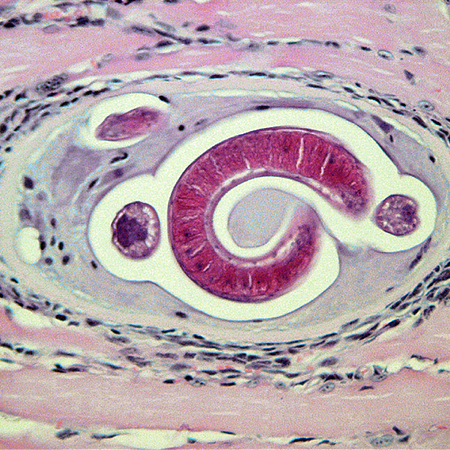Worms use immune system to extract food from cells
By Merry R. Buckley

White blood cells are usually our allies in fighting infections, but new research shows that when Trichinella worms first invade muscle cells, one particular type of white blood cell doesn’t attack – rather it helps the worms extract nutrients from the body, making the worms stronger and more successful.
Lead author Lu Huang says this leg up from the immune system is necessary for Trichinella to grow normally. A postdoctoral associate in the Department of Microbiology and Immunology in Cornell’s College of Veterinary Medicine, Huang says these cells, called eosinophils, may play this same subversive role in many other parasitic worm infections.
“Large numbers of eosinophils flock to sites of infection in all worm infections,” says Huang. “Once they’re there they can promote nutrient uptake, providing a favorable environment for the worms.”
This is a tactic controlled by the worm, says senior author Judy Appleton, vice provost, director of Engaged Cornell and the Alfred H. Caspary Professor of Immunology at the Baker Institute for Animal Health in the College of Veterinary Medicine. “The worm stimulates an immune response, then co-opts the immune response to help itself.”
In previous work, Appleton’s lab showed that eosinophils helped worms survive in the body by tamping down the production of nitric oxide (NO), a gas that the immune system produces and is toxic to Trichinella worms. Their follow-up work, described in the December 2015 PLOS Pathogens, revealed the eosinophils not only prevented this gas attack on Trichinella, their presence was actually necessary for the worm to thrive.
“We found that muscle tissue is mounting a repair response, like it would against an injury. Then the eosinophils are coming in, presumably to help with the repair, but coincidentally they help the parasite grow. We found evidence of a shift in metabolism in the muscle that would provide more glucose to the worm,” says Appleton.
These gifts of forbearance (withholding a gas attack) and sustenance (providing glucose) that eosinophils bestow upon parasitic worms are surely bad news for the infected host, but Appleton points out that this knowledge is power in the battle to end parasitic worm infections, which currently effect an estimated 2 billion people worldwide. Knowing that eosinophils may not be our allies in fighting these pathogens can push the science in the right direction, she says.
“When you vaccinate for an infectious disease, you’re trying to induce a certain kind of immune response,” she says. The dogma on eosinophils used to be that they are helpful in combatting infection, but Appleton’s lab has revealed that stimulating eosinophils would likely help a parasite to survive within the host.
“Understanding the roles these blood cells can play will help in developing effective therapeutics that use the immune system. If you boost the eosinophils in a worm infection you might get a result that you don’t want.”
Merry R. Buckley, Ph.D., is education and outreach program manager for the Baker Institute for Animal Health.
Media Contact
Get Cornell news delivered right to your inbox.
Subscribe